 Anyone who is a fan of Magic: The Gathering already knows Randy Gallegos’ artwork well. He’s done over 150 of them thus far, as well as contributing art to different Dungeons & Dragons books, including the fifth edition’s Player’s Handbook. Well-versed in science fiction and fantasy, Gallegos work spans many different subjects beyond the imaginary, including everyday objects. He’s created art for major companies like Hasbro, Upper Deck, and Blizzard Entertainment; as well as for individual clients. Examples of his work can be seen on his website, including some of the amazing pieces he’s done in his series that celebrates video game hardware as fine art, Hearts for Hardware. Prints can be purchased, as well as the original pieces themselves in some cases.
Anyone who is a fan of Magic: The Gathering already knows Randy Gallegos’ artwork well. He’s done over 150 of them thus far, as well as contributing art to different Dungeons & Dragons books, including the fifth edition’s Player’s Handbook. Well-versed in science fiction and fantasy, Gallegos work spans many different subjects beyond the imaginary, including everyday objects. He’s created art for major companies like Hasbro, Upper Deck, and Blizzard Entertainment; as well as for individual clients. Examples of his work can be seen on his website, including some of the amazing pieces he’s done in his series that celebrates video game hardware as fine art, Hearts for Hardware. Prints can be purchased, as well as the original pieces themselves in some cases.
Recently, Sega-16 had the chance to talk to Mr. Gallegos about his art and his series on gaming hardware.
Sega-16: What kinds of games do you enjoy playing?
Randy Gallegos: I have a broad palate, so it’s easier to say what genres I tend to avoid: first-person shooters (FPS), multi-player, online battle arena (MOBA), and “real” sports games. I try all kinds of other games and maybe lean towards JRPG and turn-based strategy.
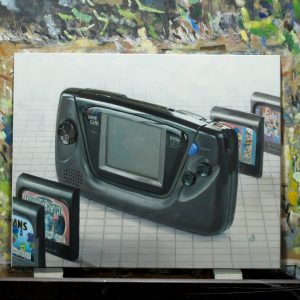 Sega-16: You’ve mentioned that you enjoyed playing Phantasy Star IV. Were you into the Genesis during its heyday, or did you discover it later on?
Sega-16: You’ve mentioned that you enjoyed playing Phantasy Star IV. Were you into the Genesis during its heyday, or did you discover it later on?
Randy Gallegos: More later, to be honest. We were a one-console family, and it was Nintendo during those years. I recall during the SMS days, I used to go to the store and play Space Harrier or OutRun or whatever and did have to admit the SMS had way better graphics than the NES. The games were much more expensive though for some reason, and the box art made me sad as a budding artist.
During the Genesis years though my brother had a SNES (he was a Street Fighter II nut) and I played some on that, but those were also the years I was at art college, and so I missed a lot of that era in general. I would play Sonic and Streets of Rage at my buddy’s house. We did have a Game Gear which I enjoyed, and I later really liked the Dreamcast (Shenmue II being one of my top three games, and yes I imported it)
I rediscovered the Genesis era through the series of re-releases on the GBA. I played the Phantasy Star Collection and Shining Force in their GBA re-releases and really enjoyed them (well, not so much PS3). The Wii had me delving in earnest into the Genesis stuff I missed. I only just beat Sonic on my own in the past year (I know) and need one or two more plays to finish Sonic 2. I now own a Genesis of course, and look forward to playing Gauntlet IV on it, but I’ve mostly used the Virtual Console for Genesis games due to the better connection cables.
The last game I finished was Shining Force II, so I’m still discovering!
Sega-16: How did your “Hearts for Hardware” series come about?
Randy Gallegos: I’d been starting to do your usual still life paintings: fruits, vegetables and so on. It was late winter and there was little of interest to paint on that front, so I grabbed some controllers (I think Wii Remotes or my Wavebird) and painted them. It was super fun, and it made me think a lot about video games, the genre of still life painting and so on. I won’t wax philosophical here about all that, but it led me down a great rabbit-trail!
Sega-16: Is this the first time you’ve chosen to use video games as subject material?
Randy Gallegos: I’ve done some art for a couple of video games as an illustrator over the years, so yes, in that sense. For my own art, I don’t think I’ve used video games as inspiration before. As a kid, I used to copy video game box art, but that was earlier – the Atari 2600/Colecovision eras.
Sega-16: You’ve done a great deal of artwork for Magic: The Gathering cards. Did you ever get gaming-related requests from people who recognized your work?
Randy Gallegos: At events where I appeared to do signings, I was often asked to do little doodles or make alterations. I think I might have had a video game request once or twice. Recently, a collector asked me to do a playmat drawing of my “Uba Mask” illustration (Champions of Kamigawa) with the mask replaced by Majora’s Mask, which was a brilliant idea, Majora’s Mask being in my top five, probably.
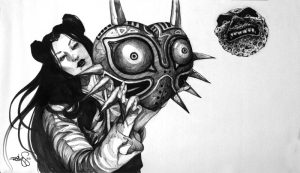 Sega-16: How do you prepare to paint a particular console? Do you have a standard process, or is each machine handled differently?
Sega-16: How do you prepare to paint a particular console? Do you have a standard process, or is each machine handled differently?
Randy Gallegos: First, I procure hardware. I’d owned a lot of hardware since the 2600 days, but since we were a one-console family we had to get rid of each one before an upgrade. So I’ve repurchased a lot, and also am grateful to borrow from people who’ve offered, because buying for the sake of this series can get expensive. I promise I’ll return things and give freebies if your readers have Sega hardware I could borrow!
Then, I will sometimes try to think of visual tie-ins I can make with something about the console’s history. For the Genesis series, I made the ground a cracked/eroded checker hearkening back to the Sonic days. The Game Gear is on a pattern that echoes the box art of the Master System; since the GG is so similar to the SMS, I intend to paint the SMS eventually in the same lighting/ground setup. So that’ll be a clearer tie later. Not everything requires a “hook,” but if I can think of one, I enjoy that.
From there I give the hardware a good cleaning and then photograph it based on my concept. I end up blending photographic reference with made up aspects (like that Genesis ground). I start in acrylic painting getting the base layers, and switch to oils. Though the finals sometimes look photographic, my goal is to remain kind of loose in my paint handling.
Sega-16: Is there a particular machine or hardware that you’re especially interested in painting but haven’t done yet?
Randy Gallegos: So many. The planned series is quite extensive if I can continue on. I am looking forward to this series being an excuse to get my hands on import systems to paint. The SEGA Mark III, Famicom, and if I can get a hold of one, the Apple Pippin are of particular interest on the unusual side.
On the more common side, I am looking forward to the Game Cube and to maybe doing a couple of very small Dreamcast VMU paintings, since the hardware in the original paintings is meant to look about actual size. So a VMU painting would be quite small, maybe 3×5″!
Sega-16: Your paintings of Sega consoles and controllers are incredibly lifelike (I love that Game Gear one!), and they seem to convey a sense of identification beyond artistic perception. There seems to be a good deal of Sega love in them! How did it feel to paint such iconic hardware?
Randy Gallegos: Each one has had a special feeling of joy, because either I get to recall my earlier gaming days with the item, or the games I played that were from that era. Even with hardware I never owned, there are a lot of good feelings attached. For instance, I’m currently painting the TurboGrafx-16, which I never owned. I was always curious about it, but I’ve since played a number of games on the Virtual Console also, and so the hardware is like a time machine for me, and that’s a cool feeling.
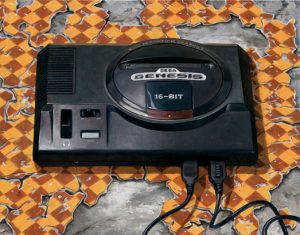 Sega-16: Are you planning to include other Sega hardware, like the Sega CD or Nomad in the series?
Sega-16: Are you planning to include other Sega hardware, like the Sega CD or Nomad in the series?
Randy Gallegos: Absolutely. Saturn, Dreamcast – all the major releases. The hard part is in the Genesis era, since there were so many configurations. I’m tempted to paint the other two models, but like for the CD, do I go CDX, side-by-side [model 2], or top-bottom [model 1]? I think the answer, in part, will be dependent on if people end up buying the art or prints; there’s a lot of ground to cover and this stuff takes time to do!
Sega-16: How has the response been from the gaming community? Have you seen interest from younger gamers who weren’t around when many of these consoles were in their prime?
Randy Gallegos: Currently it’s more retro gamers or older gamers fondly remembering their youth. Part of it is that I haven’t gone “on the road” a lot with the series yet. As I get out in the public more, I look forward to seeing more reactions in general. That’ll start this summer again.
We are very grateful to Mr. Gallegos for chatting with us! For more information on his art, check out his website and view some of his impressive artwork in the galley below (all images are property of Randy Gallegos).

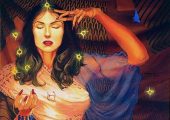
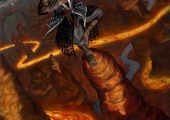
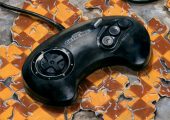
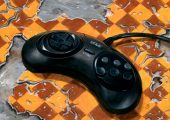
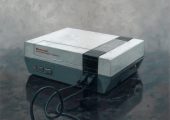
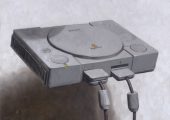
Recent Comments